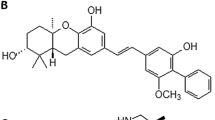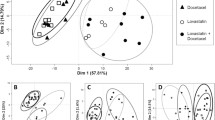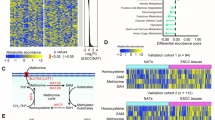Abstract
NME4, also designated nm23-H4 or NDPK-D, has been known for years for its well-established roles in the synthesis of nucleoside triphosphates, though; little has been known regarding the differential metabolites involved as well as the biological roles NME4 plays in proliferation and invasion of esophageal squamous cell carcinoma (ESCC) cells. To understand the biological roles of NME4 in ESCC cells, lentiviral-based short hairpin RNA interference (shRNA) vectors were constructed and used to stably knock down NME4. Then, the proliferative and invasive variations were assessed using MTT, Colony formation and Transwell assays. To understand the metabolites involved after silencing of NME4 in ESCC cells, widely targeted metabolomic screening was taken. It was discovered that silencing of NME4 can profoundly suppress the proliferation and invasion in ESCC cells in vitro. Metabolically, a total of 11 differential metabolites were screened. KEGG analyses revealed that Tryptophan, Riboflavin, Purine, Nicotinate, lysine degradation, and Linoleic acid metabolism were also involved in addition to the well-established nucleotides metabolism. Some of these differential metabolites, say, 2-Picolinic Acid, Nicotinic Acid and Pipecolinic Acid were suggested to be associated with tumor immunomodulation. The data we described here support the idea that metabolisms occurred in mitochondrial was closely related to tumor immunity.



Similar content being viewed by others
References
Boissan M, Schlattner U, Lacombe ML (2018) The NDPK/NME superfamily: state of the art. Lab Investig 98:164–174. https://doi.org/10.1038/labinvest.2017.137
Boissan M, Dabernat S, Peuchant E, Schlattner U, Lascu I, Lacombe ML (2009) The mammalian Nm23/NDPK family: from metastasis control to cilia movement. Mol Cell Biochem 329:51–62. https://doi.org/10.1007/s11010-009-0120-7
Wang W, Dong M, Cui J, Xu F, Yan C, Ma C, Yi TW, Dong J, Wei Y (2019) NME4 may enhance nonsmall cell lung cancer progression by overcoming cell cycle arrest and promoting cellular proliferation. Mol Med Rep 20:1629–1636. https://doi.org/10.3892/mmr.2019.10413
Liu L, Li M, Zhang C, Zhang J, Li G, Zhang Z, He X, Fan M (2018) Prognostic value and clinicopathologic significance of nm23 in various cancers: a systematic review and meta-analysis. Int J Surg 60:257–265. https://doi.org/10.1016/j.ijsu.2018.10.035
Wang QH, Han W, Chen MB, Bao J, Wang BF (2018) Prognostic value of NM23 in patients with gastric cancer: a systematic review and meta-analysis. J Cancer Res Ther 14:S556–S564. https://doi.org/10.4103/0973-1482.183188
Milon L, Rousseau-Merck MF, Munier A, Erent M, Lascu I, Capeau J, Lacombe ML (1997) nm23-H4, a new member of the family of human nm23/nucleoside diphosphate kinase genes localised on chromosome 16p13. Hum Genet 99:550–557. https://doi.org/10.1007/s004390050405
Lacombe ML, Tokarska-Schlattner M, Boissan M, Schlattner U (2018) The mitochondrial nucleoside diphosphate kinase (NDPK-D/NME4), a moonlighting protein for cell homeostasis. Lab Investig 98:582–588. https://doi.org/10.1038/s41374-017-0004-5
Lacombe ML, Milon L, Munier A, Mehus JG, Lambeth DO (2000) The human Nm23/nucleoside diphosphate kinases. J Bioenerg Biomembr 32:247–258. https://doi.org/10.1023/a:1005584929050
Han W, Shi CT, Cao FY, Cao F, Chen MB, Lu RZ, Wang HB, Yu M, He DW, Wang QH, Wang JF, Xu XX, Ding HZ (2016) Prognostic value of NME1 (NM23-H1) in patients with digestive system neoplasms: a systematic review and meta-analysis. PLoS ONE 11:e0160547. https://doi.org/10.1371/journal.pone.0160547
Thakur RK, Yadav VK, Kumar P, Chowdhury S (2011) Mechanisms of non-metastatic 2 (NME2)-mediated control of metastasis across tumor types. Naunyn Schmiedebergs Arch Pharmacol 384:397–406. https://doi.org/10.1007/s00210-011-0631-0
Yang T, Chen BZ, Li DF, Wang HM, Lin XS, Wei HF, Zeng YM (2016) Reduced NM23 protein level correlates with worse clinicopathologic features in colorectal cancers: a meta-analysis of pooled data. Medicine (Baltim) 95:e2589. https://doi.org/10.1097/MD.0000000000002589
Negroni A, Venturelli D, Tanno B, Amendola R, Ransac S, Cesi V, Calabretta B, Raschella G (2000) Neuroblastoma specific effects of DR-nm23 and its mutant forms on differentiation and apoptosis. Cell Death Differ 7:843–850. https://doi.org/10.1038/sj.cdd.4400720
Huang H, Colella S, Kurrer M, Yonekawa Y, Kleihues P, Ohgaki H (2000) Gene expression profiling of low-grade diffuse astrocytomas by cDNA arrays. Cancer Res 60:6868–6874
Hayer J, Engel M, Seifert M, Seitz G, Welter C (2001) Overexpression of nm23-H4 RNA in colorectal and renal tumours. Anticancer Res 21:2821–2825
Seifert M, Welter C, Mehraein Y, Seitz G (2005) Expression of the nm23 homologues nm23-H4, nm23-H6, and nm23-H7 in human gastric and colon cancer. J Pathol 205:623–632. https://doi.org/10.1002/path.1724
Heng B, Lim CK, Lovejoy DB, Bessede A, Gluch L, Guillemin GJ (2016) Understanding the role of the kynurenine pathway in human breast cancer immunobiology. Oncotarget 7:6506–6520. https://doi.org/10.18632/oncotarget.6467
Kimura Y, Negishi H, Matsuda A, Endo N, Hangai S, Inoue A, Nishio J, Taniguchi T, Yanai H (2018) Novel chemical compound SINCRO with dual function in STING-type I interferon and tumor cell death pathways. Cancer Sci 109:2687–2696. https://doi.org/10.1111/cas.13726
Adams S, Teo C, McDonald KL, Zinger A, Bustamante S, Lim CK, Sundaram G, Braidy N, Brew BJ, Guillemin GJ (2014) Involvement of the kynurenine pathway in human glioma pathophysiology. PLoS ONE 9:e112945. https://doi.org/10.1371/journal.pone.0112945
Wang C, Liu R, Lim GH, de Lorenzo L, Yu K, Zhang K, Hunt AG, Kachroo A, Kachroo P (2018) Pipecolic acid confers systemic immunity by regulating free radicals. Sci Adv 4:eaar4509. https://doi.org/10.1126/sciadv.aar4509
Gordon DM, Lyver ER, Lesuisse E, Dancis A, Pain D (2006) GTP in the mitochondrial matrix plays a crucial role in organellar iron homoeostasis. Biochem J 400:163–168. https://doi.org/10.1042/BJ20060904
Platten M, Nollen EAA, Rohrig UF, Fallarino F, Opitz CA (2019) Tryptophan metabolism as a common therapeutic target in cancer, neurodegeneration and beyond. Nat Rev Drug Discov 18:379–401. https://doi.org/10.1038/s41573-019-0016-5
Mills EL, Kelly B, O’Neill LAJ (2017) Mitochondria are the powerhouses of immunity. Nat Immunol 18:488–498. https://doi.org/10.1038/ni.3704
Sukumar M, Kishton RJ, Restifo NP (2017) Metabolic reprograming of anti-tumor immunity. Curr Opin Immunol 46:14–22. https://doi.org/10.1016/j.coi.2017.03.011
Acknowledgements
The study was partly supported by Nature Science Foundation of China (NSFC.81960552, 81960527, 81960527, U1603284, 81860511), and partly by Science and Technology Projects of Xinjiang Uygur Autonomous Region (2018E02067), by Tianshan Xuesong Project of the Xinjiang Uygur Autonomous Region (2018XS19).
Author information
Authors and Affiliations
Corresponding author
Ethics declarations
Conflict of interest
The authors declare that there was no conflict of interests.
Additional information
Publisher's Note
Springer Nature remains neutral with regard to jurisdictional claims in published maps and institutional affiliations.
Electronic supplementary material
Below is the link to the electronic supplementary material.
Rights and permissions
About this article
Cite this article
Zheng, S., Liu, T., Liu, Q. et al. Widely targeted metabolomic analyses unveil the metabolic variations after stable knock-down of NME4 in esophageal squamous cell carcinoma cells. Mol Cell Biochem 471, 81–89 (2020). https://doi.org/10.1007/s11010-020-03768-w
Received:
Accepted:
Published:
Issue Date:
DOI: https://doi.org/10.1007/s11010-020-03768-w




